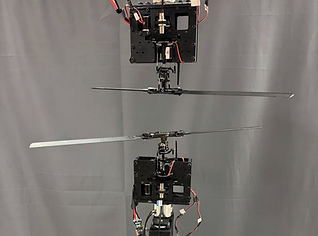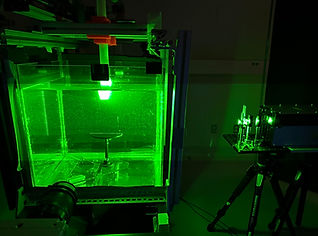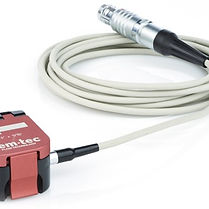
Facilities

Avian Gust Interaction Indoor Flight Arena
The avian gust interaction indoor flight arena is a modular experimental setup capable of recording the coordinate position of natural flyers traversing unsteady gusts. With the support of the Auburn University Raptor Center, AFRG has employed a novel approach to study the kinematics of bird and gust interactions. With high-speed cameras, the flight morphology of a Red-Tail Hawk encountering an unsteady flow environment has been characterized, and future studies will deepen our understanding of rapid avian flight maneuvers in the presence of unsteady flow.

Vacuum Chamber
This facility is used to study Plume-Surface Interactions (PSI) under rarefied atmospheric conditions, that are observed during touchdown or lift-off of landers in extra-terrestrial environments, to improve our understanding of the erosion processes and mechanisms. The facility can be operated over a range of conditions that span between earth to near-lunar atmospheric pressures. The facility houses a nozzle assembly to emulate plumes generated by landers, and a simulant granular bed. It also has optical access for externally mounted sources of illumination (Laser / LED lights) and cameras, to capture images of craters, and trace particles ejected due to erosion.

Hydrodynamic Towing Tank Facility
The towing tank facility is useful for experiments involving unsteady and free-surface hydrodynamics. The towing tank enables precise control over model velocity and acceleration, making it well-suited for studying unsteady wake behavior. This facility provides a controlled environment for investigating hydrodynamic forces, vortex shedding, and flow instabilities in scenarios where steady-state testing is insufficient.

Aerodynamic Multi-Rotor Facility
The multi-rotor facility is used to examine the complex aerodynamic environment surrounding two rotors in close proximity. The coaxial rotor concept (shown here) is gaining significant applicability in many domains, including personal, military, and space operations, so developing a deep understanding of the aerodynamics is paramount towards developing and implementing coaxial rotors into the rotorcraft community. This facility is equipped to gather performance and flow field measurements.

Hydrodynamic Hovering Rotor Facility
The hydrodynamic hovering rotor facility is a 4' x 4' x 4' acrylic tank designed to investigate fundamental flow physics governing the performance of a hovering rotor. A novel technique, Rotating Three-Dimensional Velocimetry (R3DV), enables quantification of the 3D flow field of a rotating wing over a wide azimuthal range. This methodology provides insight into the temporal and spatial evolution of wake structures generated during wing rotation, offering a deeper understanding of rotor aerodynamics.

Vortex Ring Generator
The vortex ring generator facility is used to investigate vortical flow interactions. From modeling human coughs to cardiac flows, this facility has a broad range of applicability. Included in the design of the facility is a variable surface plate apparatus that enables the investigation of vortex ring interactions with a wide range of surface geometries. The facility is equipped for flow visualization, particle image velocimetry, and pressure measurement techniques.

Left Heart Simulator
The left heart simulator is a specialized facility designed for studying cardiovascular fluid mechanics. This system replicates the pulsatile flow conditions of the human heart, enabling investigations into heart valve dynamics, ventricular flow patterns, and the complex interactions between blood flow and cardiovascular structures. The simulator provides a controlled environment for testing prosthetic heart valves. By accurately reproducing physiological conditions, this facility supports research in biomedical fluid dynamics, contributing to advancements in cardiovascular healthcare and medical device development.

Pulsatile Cough Simulator
The pulsatile cough simulator is used to emulate human expiratory events such as coughs and sneezes that are generally intermittent or pulsatile in nature. This experimental fixture generates well controlled, pulsed plumes that are dispersed with micron sized droplets. The fixture can be used to characterize the transmission of viruses during expiratory events.

Water Tunnel
We have access to a water tunnel with an 18" × 16" test section and a maximum flow speed of 4 ft/s. This facility allows for controlled, repeatable flow conditions, making it well-suited for high-resolution performance measurements, and flow visualization and velocimetry techniques. The water tunnel enables the study of laminar-to-turbulent transition, vortex dynamics, and wake interactions in a stable, low-turbulence environment.

Wind Tunnel
We have access to a low-speed, open-circuit wind tunnel, featuring a 24" × 24" test section and a maximum speed of 130 ft/s, making it suitable for a wide range of aerodynamic experiments. The wind tunnel supports force and moment measurements, surface flow visualization, and particle image velocimetry (PIV), allowing for detailed investigations of flow separation, wake development, and airfoil performance under realistic aerodynamic conditions.
Instrumentation

Time-Resolved Particle Image Velocimetry (PIV)
The time-resolved PIV system can be configured for stereoscopic and tomographic PIV, it consists of
-
4 high-resolution high-speed cameras (2 - VEO 640S and 2 - VEO 4K)
-
Microlens arrays to convert to Plenotpic cameras for light-field imaging
-
A high-speed laser with a pulse energy of 30 mJ/pulse at 1,000 Hz
-
Synchronization timing units, data acquisition, and processing software from LaVision
-
Specialized seeding generators - Helium-Filled Soap Bubble generator from LaVision
-
Articulated laser arm and sheet optics from ILA

Force/Torque Sensors
Loadcells of varying load range and applications are available.
-
Uniaxial and biaxial force and torque transducers
-
ATI six-axis loadcells - ATI Nano and ATI Mini
-
Associated signal conditioning hardware for each of the transducers
-
Custom-developed LabVIEW software and National Instruments DAQ

Pulsatile Flow Sensors
Ultrasound-based clamp-on transducer
- Sampling rate of 100 Hz
-
Maximum flow rate of 583 cc/s (35 L/min).
-
Associated signal conditioning hardware, National Instruments cDAQ systems, and LabVIEW

Unsteady Pressure Transducer
Differential Pressure transducers
-
Measurement range for applications from Aerodynamics to Biofluids
-
Associated signal conditioning hardware, National Instruments cDAQ systems, and LabVIEW
